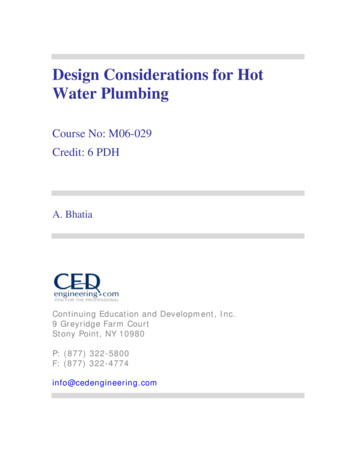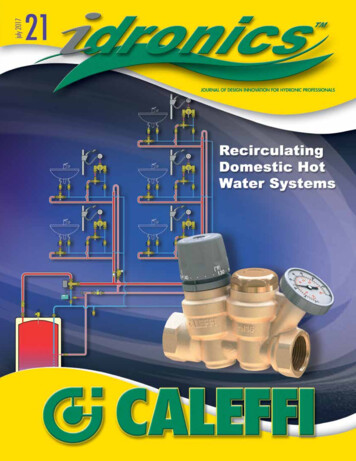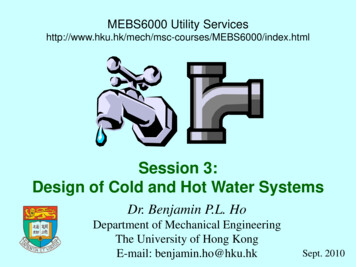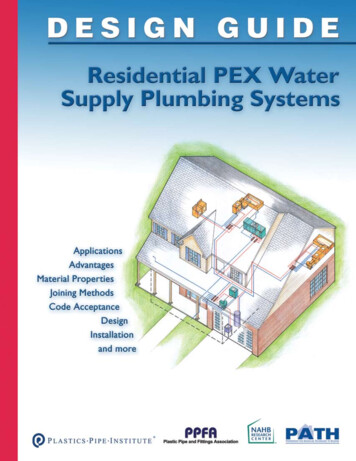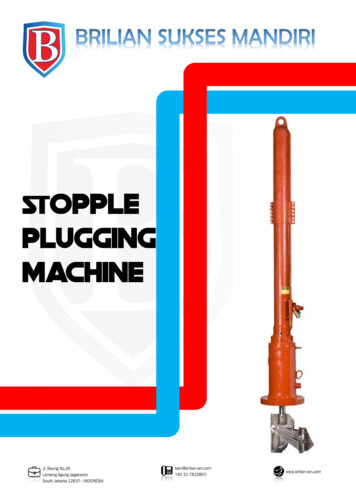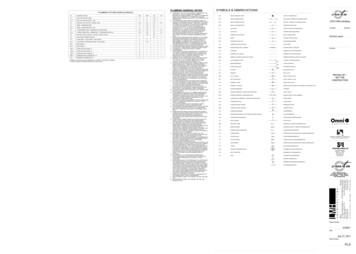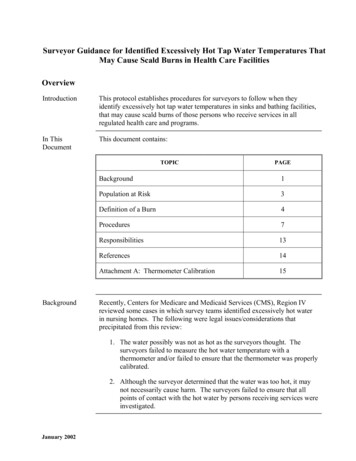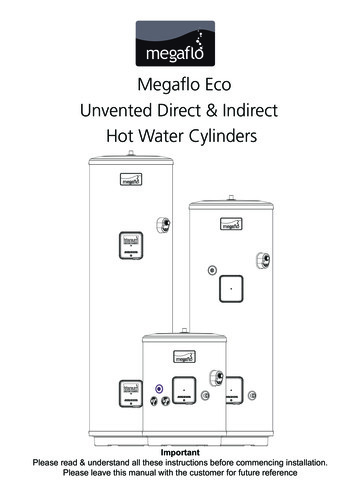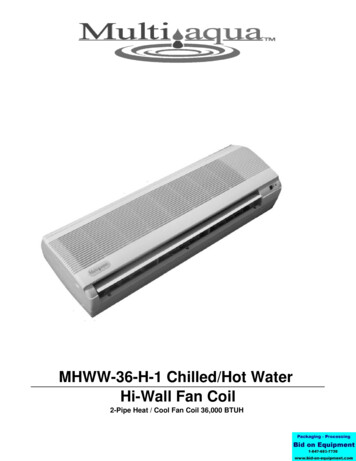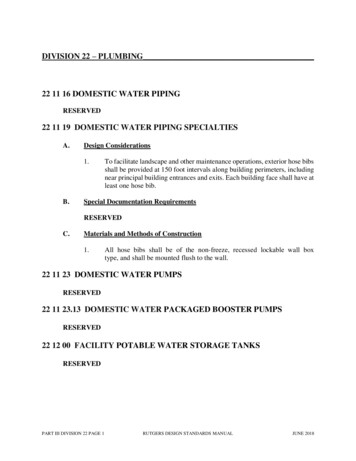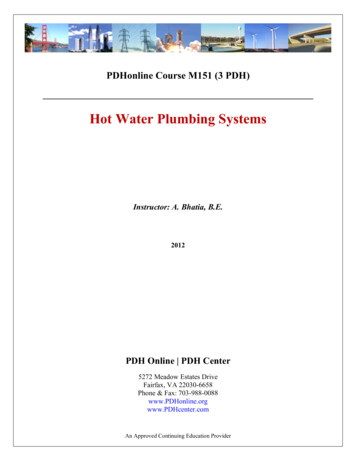
Transcription
PDHonline Course M151 (3 PDH)Hot Water Plumbing SystemsInstructor: A. Bhatia, B.E.2012PDH Online PDH Center5272 Meadow Estates DriveFairfax, VA 22030-6658Phone & Fax: 703-988-0088www.PDHonline.orgwww.PDHcenter.comAn Approved Continuing Education Provider
Hot Water Plumbing SystemsCourse ContentPART 1Estimating Hot Water DemandPlumbing service design practice may be regarded as an art rather than a science. Hot waterdemand varies with the type of establishment, usage, occupancy, fixture types, time of day andhost of other factors. The system should be capable of meeting peak demand at an acceptableefficiency levels.For small domestic applications the estimate can be found by applying standard rule of thumbs.How much hot water do you need?Domestic hot water use varies widely depending upon a number of factors including how manypeople live in your home and the age of those people.To make your choice easier, just ask yourself the following questions: How many people are there in your family? How many bathrooms do you have? How many appliances such as washing machines, dishwashers etc require hot water? Do you have a pool or spa? Do you have many visitors staying in your home? Are there teenagers in the family? (They tend to use more water)Hot water demand varies with each individual living habit, but 15-20 gallon per person per day isa conservative estimate.DOMESTIC HOT WATER USEThree primary usage of hot water in domestic needs is in bathroom, kitchen and laundry.BathroomTypically most hot water is used in the bathroom. The amount of hot water you consume willdepend on whether you prefer to take showers or baths.
If you take showers, you can calculate the amount of total water you use by multiplying therunning time of your shower by the flow rate of the showerhead.Total water use running time x flow rate of showerheadShowerhead flow rates can vary between 1.5 and 7gpm. A standard showerhead can deliver upto 7gpm (70 gallons for a 10 minute shower) while a low-flow showerhead typically averages adelivery rate of 1.5 to 4gpm (15-40 gallons for a 10 minute shower). The best way to determineyour showerhead flow rate is to time how long it takes to fill a container of known volume, such asa 5 liter bucket. The following equation will help you to calculate the flow rate (liters per minute):Flow rate (60 seconds seconds taken to fill container) x container volume in litersFor example, if a 5-liter bucket takes 40 seconds to fill, then the flow rate is equal to 7.5 liters perminute ( 2gpm) (60 seconds 40 seconds x 5 liters).Remember to consider your future needs when estimating your hot water consumption.A hot water system will last you a number of years so you will need to consider any possiblechanges to your household in the future. Younger children grow up to become teenagers whohave a tendency to take longer showers N E R G YOnce you’ve multiplied the flow rate of the showerhead by the shower running time, you need tomultiply the result by the ratio of hot water to cold water used to determine your total hot wateruse. Generally, hot water is mixed with around 30-40%cold water in the shower.Total hot water use total water used x hot water mix (60%-70%)A low flow showerhead with a flow rate of 2.5gpm during a 10-minute shower will use 25 gallonsof water. With a hot water mix of 70%, the total hot water use is 17.5 gallons (25 x 0.7).If you take baths, you can calculate your hot water use by multiplying the total volume of waterrequired to fill the bath by the hot water mix. If your bath takes 25 gallons of water to fill (which isabout average), it will require about 15 to 17.5 gallons of hot water (based on a cold water mix of30%-40%).Spa baths typically take 65 to 90 gallons of water to fill and will therefore require a largervolume of hot water.Some spa baths and larger spa pools are connected to a cold-water tap and heat their own water.If this is the case, their hot water consumption does not need to be taken into account whensizing your hot water system, as they do not place a demand on your hot water system.LaundryThe laundry is another room that places a demand on your hot water system.
A standard warm wash cycle typically uses 8 to 13 gallons of hot water per wash. You can saveon hot water use by washing clothes in cold water or using a front-loading machine if you stillneed to wash clothes in hot water. Front-loading machines generally use much less water thantop loading machines.KitchenThe amount of hot water you use in the kitchen will vary depending upon whether you have adishwasher and if so, how it is set up. Most dishwashers are connected to the cold-water tap anduse an electric element inside the dishwasher to heat the water. If this is the case, they will placea demand on your electricity bills and not on your hot water system.If your dishwasher does have a hot water connection, it will consume between 3 and 25 gallons ofhot water per wash and, therefore needs to be taken into consideration when sizing your hotwater system. Proper flow pressure must be maintained to achieve efficient dishwashing.National Sanitation Foundation (NSF) standards for dishwasher water flow pressures are 15-psigminimum, 25-psig maximum and 20-psig ideal. Flow pressure is the line pressure measuredwhen water is flowing through the rinse arms of the dishwasher. A pressure regulator (set at 20psig) should be installed in the supply water line adjacent to the dishwasher and external to thereturn-circulating loop, if used. To find out which type of dishwasher you have and how muchwater it uses, simply consult the operating instructions.Typical Residential Usage of Hot Water per TaskUseHigh Flow (gal)Low Flow (gal) when watersavers usedFood Preparation53Hand dish washing44Automatic dishwasher1515Clothes washer3221Shower or bath2015Face and hand washing42(Source ASHRAE Application Handbook, Chapter 45, table 4)SIZING HOT WATER DEMANDSThe information on sizing the potable water (cold & hot water) is defined in the American Societyof Heating, Refrigeration and Air Conditioning Engineers “ASHRAE 1991” ApplicationsHandbook, Uniform Plumbing Code (UPC) and American Society of Plumbing Engineers (ASPE)
handbooks. All these criterions focus on the use of probability theory to compensate forunknowns. The required flow rates are defined based on “Fixture Unit Count” method, whichtakes into consideration people use factors, people socio-economic factors, facility types, fixturetypes and host of other factors. This method permits the tabulation of total fixture units bysumming individual fixture demands. The water demand can than be estimated from a fixtureunit-water demand curve.Table-1 below provides a list of representative fixtures.TABLE – 1Demand weights of plumbing items in ‘Fixture Unit’Fixture or GroupWater Closet (FlushValve)Water Closet (FlushTank)Pedestal Urinal (FlushValve)Stall or Wall Urinal(Flush valve)Stall or Wall Urinal(Flush Tank)Lavatory (Faucet)Bathtub (Faucet)Shower Head (Mixvalve)Service Sink (Faucet)Kitchen Sink (Faucet)Water Closet (Flushvalve)Water Closet (Flushtank)Lavatory (Faucet)Bathtub (Faucet)Shower Head (Mixvalve)Bathroom Group(Flush valve)Bathroom Group(Flush tank)Shower (Mix valve)Kitchen Sink (Faucet)Laundry Trays (Faucet)Combination FixtureOccupancyPublicTotalBuildingSupply HW &CW10Cold Water(CW) onlyHot Water(HW) 2331-1/21-1/22-1/42-1/41-1/21-1/22-1/42-1/4
Fixture or pply HW &CW4Cold Water(CW) only3Hot Water(HW) only3(Source: National Bureau of Standard Reports: BMS79 by R. B. Hunter. Another source of information is available inchapter 45, ASHRAE Applications Handbook, Table-1 that provides information on the fixture unit’s facility wise forapartments, club, gymnasium, hospital, hotels, industrial plant, office building, school etc. The above table is generic andcan be conceptually applied to any application)From the tabulated fixture units as shown above, the designer can assign fixture unit values tothe specific fixtures of concern in his design. The sum total of fixture units is total fixture unitcount.Both hot and cold service water will be needed inside the building. As a rule, separate hot andcold-water demand can be taken as ¾ the total shown.Note: The fixture unit count method could be applied to any of the residential or non-residentialdemand.Fixture Unit – Flow RelationshipOnce the total fixture count is obtained, the next step is to co-relate this to the probable flow.It is well known that as the number of fixtures increases the probability of simultaneous usedecreases. Flow probability, as a function of fixture unit count shall vary with type of facility anddepends on time usage and other specific requirements. The figure below shows the probabilityof flow as a function of fixture unit count.
FLOW-FIXTURE UNITS RELATIONSHIP(Approximate, not to scale, refer figure 24,ASHRAE Applications Handbook, chapter 45)10090DEMAND - GPM8070C6050ntsuraatsReevruhom es,tal, nursingCurve-H os piot elsm&lstehodormitor ies,ment/ housesCurve-ApartSchoolse build ings ,Curve-Off ic40302010255075 100 125 150 175 200 225 250 275FIXTURE UNITSService water distribution pipe flow rate can be related to the fixture count served by any branchor main section of piping. In practice, the engineer counts fixtures from the circuit end, totalingfixture units as he proceeds to the circuit start. Each piping section then serves a stated numberof fixture units, which is related to the flow requirement as in figure above. This method shall beused for sizing instantaneous/ semi-instantaneous water heaters and also the pipe sizing.The minimum recommended size for semi-instantaneous heater is 10gpm, except for restaurants,which require 15gpm. While the fixture count method bases heater size on hot water flow, hotwater piping should be sized for the full flow to the fixtures for every branch.ASHARE applications handbook, chapter 45, table 9 (replicated below) provides hot waterdemand per fixture directly. This is a simplified approach that saves designer’s effort of firstestimating the fixture units and than estimating flow against the fixture units as explained above.
TABLE- 2(Hot water demand in gallons per hour GPH per fixture @ 140 F)Fixture oolBasin (private)22222222Basin (public 20-100-20-100Foot basin33123312-12Kitchen Sink1020-2030202020Laundry2028-2828--28Pantry Sink510-1010-1010Shower30150225757522530225Service Sink2020-2030202020---400----Hubbard Bath---600----Leg Bath---100----Arm Bath---35----Sitz nuous FlowBath5015050200
Circular WashSinkSemicircularWash SinkDemand FactorStorage 250.250.40.30.41.250.91.00.600.801.02.01.0(Source: ASHRAE Applications Handbook, Chapter 45, Table 9)If a particular fixture or a specific building type is not listed above, the flow rate can be assignedbased on engineering judgment, best practices historical data, or supplier’s instructions.Estimating Plumbing FixturesPlumbing fixtures specifications conform generally to American Society of Mechanical Engineers,ASME standards series A112 or International Association of Plumbing and Mechanical Officials;IAMPO standards series Z124.Most of the information on the quantity and type of plumbing fixtures is available from the buildinglead usually an architect. While conceptualizing, it is possible that the exact information on thefixture quantity may not be available. In absence of preliminary information, the minimum numberof plumbing facilities can be estimated from the table 403.1 of International Plumbing Code (IPC).The table is replicated below and the fixtures shown are based on one fixture being the minimumrequired for the number of persons indicated. The number of occupants could be determined bythe building code.TABLE -3(Minimum number of plumbing fixtures)Water inkingFountainOthers1 per 10001 service sink1 per 5001 service sink1 per 5001 service sinkMaleFemaleTheaters1 per 1251 per 651 per 200Nightclubs1 per 401 per 401 per 75Restaurants1 per 751 per 751 per 200-Halls/Museums1 per 1251 per 651 per 200-1 per 10001 service sinkChurches1 per 1501 per 751 per 200-1 per 10001 service sink
Water ClosetsOccupancyYStadiums1 per 1001 per 50DrinkingFountainOthers1 per 150-1 per 10001 service sink1 per 501 per 501 per 1001 service sinkFactory&Industrial1 per 1001 per 1001 per 4001 service sinkHigh Hazard1 per 1001 per 1001 per 10001 service sink1 per 101 per 101 per 81 per 1001 service sink1 per room1 per room1 per 151 per 1001 service sinkper floor1 per 151 per 151 per 151 per 1001 service sink1 per 251 per 35-1 per 100-1 per 751 per 100-1 per 500-1 per cell1 per cell1 per 151 per 1001 service sink1 per 151 per 151 per 151 per 1001 service sink1 per 5001 per 750-1 per 10001 service sinkHotel, motels1 per room1 per room1 per roomLodges1 per 101 per 101 per 81 per dwelling unit1 per dwellingunit1 per dwellingunit1 per 101 per 101 per 81 per dwelling unit1 per dwellingunit1 per dwellingunit1 per 1001 per 100-Hospitals,ambulatorynursing homepatientsDay nurseries,Sanitariums,nursing homesEmployeesother thanresidentialcareVisitors miliesDormitoriesOne or twofamilydwellingsStorage(Source: Table 403.1, International Plumbing Code)1 service sink1 per 1001 service sink1 service sink& 1clotheswasher per 20dwelling units1 per 1001 service sink
ASHRAE Applications Handbook, chapter 45) Service water distribution pipe flow rate can be related to the fixture count served by any branch or main section of piping. In practice, the engineer counts fixtures from the circuit end, totaling fixture units as he proceeds to the circuit start. Each piping section then serves a stated number of fixture units, which is related to the flow .
